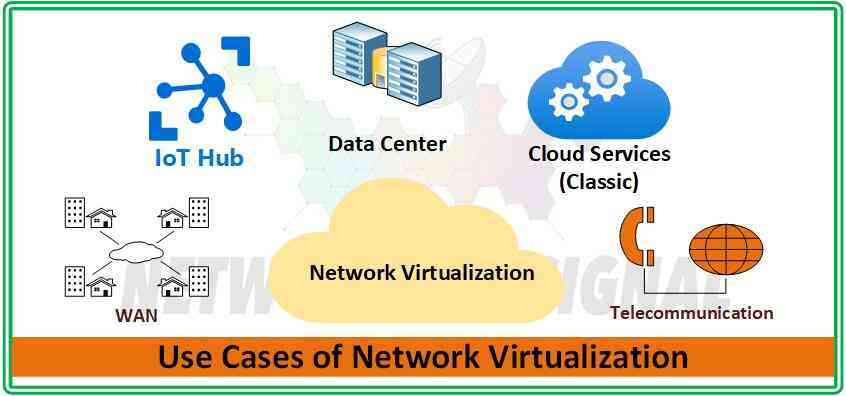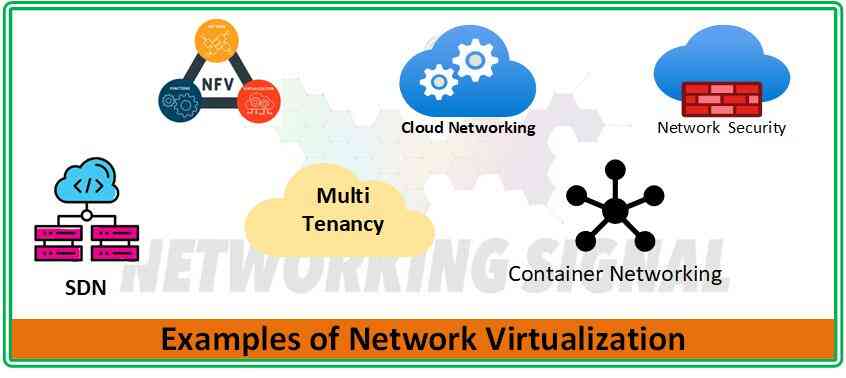What is Network Virtualization?
Network virtualization is a technique of creating multiple logical networks over a single physical network. It enables the sharing of resources among several different tenants while keeping each tenant’s data and traffic isolated from other tenants.
The advantages of network virtualization are reduced hardware costs, improved performance, scalability and flexibility for network administrators, improved security, and improved reliability. Network virtualization also allows for the dynamic allocation of resources, so that tenants can scale up or down their network usage as needed.
What are the Types of Network Virtualization?
There are two primary types of network virtualization:
- internal
- external
Internal network virtualization is used to create multiple logical networks within a single physical network, while external network virtualization is used to enable communication between different physical networks.
- Internal Network Virtualization: Internal network virtualization allows for the creation of multiple isolated logical networks over a single physical network infrastructure. It is often used in cloud computing environments to enable virtual networks to exist over a shared set of physical resources.
- External Network Virtualization: External network virtualization enables communication between different physical networks. This type of virtualization is typically used in wide-area networks, such as those that span multiple locations or geographic regions.
How Does Network Virtualization Work?

The working of network virtualization is based on the concept of logical abstraction. Each tenant has a different view of the underlying physical network and can create and manage their own virtual networks on top of it. The tenants are then able to communicate with each other over these virtual networks as if they were communicating over separate physical networks.
In order for this to work properly, the underlying physical network must be able to support multiple virtual networks. This is done through a process known as tunneling, which allows each tenant’s traffic to travel securely over the same physical network infrastructure.
What are the Benefits of Network Virtualization?
Here are some of the key benefits of network virtualization:
- Cost Savings: By creating multiple logical networks over a single physical infrastructure, network virtualization can result in significant cost savings for organizations.
- Scalability and Flexibility: Network virtualization allows for the dynamic allocation of resources so that tenants can scale up or down their network usage as needed.
- Improved Performance: Network virtualization improves network performance by reducing latency and eliminating the need for manual configuration.
- Improved Security: By isolating each tenant’s data and traffic, network virtualization can provide security benefits that are not available with traditional physical networks.
- Improved Reliability: By using multiple logical networks, organizations can increase their overall reliability by minimizing the impact of any single point of failure.
What are the Use Cases of Network Virtualization?

There are a number of use cases for network virtualization, such as:
- Cloud Computing Environments: Network virtualization can be used to enable the creation of multiple isolated virtual networks within a single physical infrastructure. This is often used in cloud computing environments to provide tenants with access to secure and reliable networking resources.
- Data Centers: By creating multiple logical networks within a single physical network, data centers can improve their utilization of resources and enable dynamic scalability.
- Wide-Area Networks: External network virtualization can be used to enable communication between different physical networks over long distances. This is often used in wide-area networks, such as those that span multiple locations or geographic regions.
- Telecommunications: Network virtualization can be used to provide telecommunications services, such as voice over IP (VoIP) and video conferencing.
- Internet of Things (IoT): Network virtualization can also be used in IoT applications, by creating multiple isolated logical networks for different types of connected devices. This makes it easier to manage and secure those devices, while also providing more flexibility in terms of network resources.
What are the Examples of Network Virtualization?

Some examples of network virtualization technologies include:
- Software-Defined Networking (SDN): SDN is the most common type of network virtualization, and involves using software to control and manage physical networking hardware.
- Network Function Virtualization (NFV): NFV is a newer type of network virtualization that enables functions, such as routing, firewalling, and load balancing, to be virtualized and run in software.
- Cloud Networking: Cloud networking is a type of network virtualization that combines the benefits of SDN and NFV to enable organizations to create secure, scalable networks in the cloud.
- Container Networking: Container networking is a type of network virtualization that is used to create isolated networks for individual applications or services in a containerized environment.
- Network Security: Network security can also be virtualized, by enabling organizations to create multiple distinct logical networks with different levels of access control and security features.
- Multi-Tenancy: Multi-tenancy is another type of network virtualization, which enables multiple tenants to use the same physical infrastructure while still maintaining isolation and security.
What are the Some Popular Network Virtualization Tools?
Some popular tools for network virtualization include:
- Cisco ACI: Cisco’s Application Centric Infrastructure (ACI) is a software-defined networking platform that enables organizations to create and manage virtual networks.
- Nuage Networks VSD: Nuage Networks Virtualized Services Director (VSD) is an end-to-end network virtualization platform that enables organizations to create and manage software-defined networks.
- Juniper Contrail: Juniper Contrail is an open-source network virtualization solution that enables organizations to create and manage virtualized networks.
- VMware NSX: VMware NSX is a network virtualization platform that enables organizations to create and manage virtual networks within their existing physical infrastructure.
- OpenStack Neutron: OpenStack Neutron is an open-source network virtualization platform that enables organizations to quickly and easily create and manage virtual networks.
- Microsoft Azure Networking: Microsoft Azure Networking is a cloud-based network virtualization solution that enables organizations to build and manage virtual networks.
- Citrix NetScaler: Citrix NetScaler is a network virtualization platform that enables organizations to create and manage virtual networks in a hybrid cloud environment.
- F5 BIG-IP: F5 Networks’ BIG-IP is a network virtualization solution that enables organizations to quickly and easily create and manage virtual networks.
- Palo Alto Networks Panorama: Palo Alto Networks’ Panorama is a network virtualization platform that enables organizations to create and manage secure virtual networks.
- Cloudify: Cloudify is an open-source network virtualization solution that enables organizations to quickly and easily create and manage multi-tenant, software-defined networks.
- Avi Networks: Avi Networks is a network virtualization platform that enables organizations to create and manage secure, scalable software-defined networks.
- HashiCorp Terraform: HashiCorp’s Terraform is an open-source network virtualization tool that enables organizations to quickly and easily create and manage virtual networks.
- Kubernetes: Kubernetes is an open-source network virtualization platform that enables organizations to quickly and easily create and manage containerized networks.
- VNS3: Cohesive Networks’ VNS3 is a network virtualization solution that enables organizations to create and manage secure, scalable software-defined networks.
- Sangfor HCI: Sangfor’s Hyper-Converged Infrastructure (HCI) is a network virtualization solution that enables organizations to quickly and easily create and manage multi-tenant, software-defined networks.
- SolarWinds Network Insight: SolarWinds’ Network Insight is a network virtualization platform that enables organizations to create and manage software-defined networks with visibility into performance, security, and compliance.
- Dell EMC Networking: Dell EMC’s Networking product is a network virtualization solution that enables organizations to create and manage secure, scalable software-defined networks.
How Does Network Virtualization Differ From Server Virtualization?
Network virtualization differs from server virtualization in a few key ways.
- Server virtualization involves running multiple operating systems and applications on a single physical server, while network virtualization enables the creation of multiple logical networks that are all hosted on the same physical infrastructure.
- Server virtualization is typically used to improve resource utilization, while network virtualization is used to improve scalability, reliability, and security.
- Server virtualization generally requires specialized hardware and software, while network virtualization can be implemented with the existing physical networking infrastructure.
What are the Potential Security Risks Associated With Network Virtualization?
- As with any technology, network virtualization comes with certain security risks that need to be managed and mitigated.
- An improperly configured virtual network can lead to a breach of confidentiality, integrity, or availability of the data it carries.
- Virtual networks are vulnerable to attacks targeting their underlying physical infrastructure.
- An attacker could potentially gain access to multiple networks if one is compromised.
What Challenges Must be Overcome Before Network Virtualization Can Become Mainstream?
Despite the potential of network virtualization, there are still a number of challenges that must be overcome before it can become mainstream.
These include:
- Vendor lock-in and interoperability issues
- Lack of standardization in technologies and toolsets
- The complexity of implementation and management
- Performance concerns due to latency and other factors
- Cost of hardware, software, and training.

